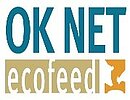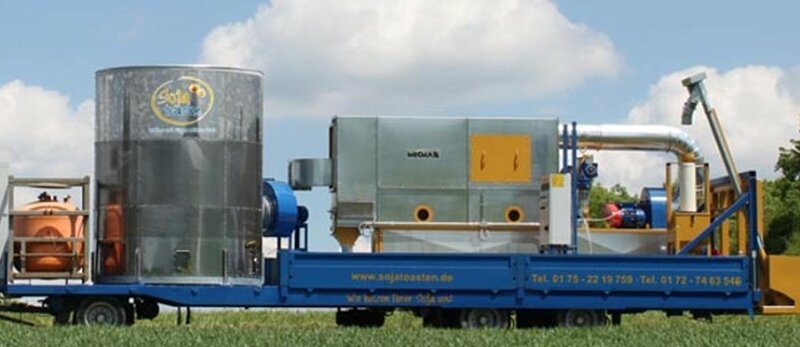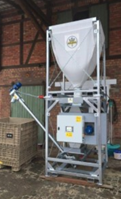Recommendations for using soy-based feedstuffs for poultry production
Problem
Soya is one of the most important sources of protein in poultry feeding. However, the high crude protein content alone is not sufficient to meet the special needs of poultry on essential amino acids. They need to be supplemented with other components to get optimal amounts and ratios.
In poultry, the feeding of raw soya beans is not possible due to digestive inhibiting components (trypsin inhibitors), and must be prepared by thermal treatment.
Soya beans have a very high oil content. Full-fat beans can therefore be used in the ration with a maximum of 10 - 12 %. In this case, the methionine-rich components such as corn gluten must also have a low raw fat content. A high raw fat content in the ration can lead to health problems.
Solution
Toasting, or roasting, the raw bean improves the digestibility and usability of the protein and extends the shelf life of the toasted beans to approximately 6-12 months. Toasting, or roasting, means the deactivation of the anti-nutritional factors (ANF) of the soya bean by heating.
There are different toasting, or roasting, methods with different effects on the quality of the soya. For the mobile solutions (figures 1 and 2), the thermal method is predominantly used.
In order to increase the quantity used from about 10 % to about 20 % in the ration, the soya bean must be de-oiled by pressing, which reduces the crude fat content from about 20 % to about 10 %.
Since synthetic amino acids may not be used in organic farming, the ration must be supplemented with components with a high methionine content. In 100% organic rations (check Table 1) rice protein or methionine-rich oil cakes such as sesame cake and sunflower cake are used for this purpose. Especially in oil cakes, the ingredients are subject to strong fluctuations. It is recommended to use several components. This reduces the influence of individual components on the total ration. Alternatively, a protein supplement can be used, which can also be individually mixed by the feed mills if sufficient quantities are required.
Benefits
- Soya can be very well integrated into crop rotation and can cover up to 80 % of the N requirement by inoculating the seed with N-fixing nodule bacteria (Bradyrhizobium japonicum).
- High added value through refinement in own plant. Soya contains a lot of energy and protein. It is very tasty for the animals and easy to digest. The high content of linoleic acid has a positive effect on the egg size of laying hens.
- Dependence on soya imports can be reduced
- The pressed oil can be sold for further use.
Applicability box
Geographical coverage
Climatic conditions, variety and the degree of ripeness appropriate to the location are determining
Application time
Year-round use in animal feeding
Required time
Output spectrum for toasting from 100-1,000 kg/h
Period of impact
Permanent
Equipment
Toaster and press
Best in
Own cultivation and use at the farm
Practical Recommendations
- Soya toasting and de-oiling is now well established and the process steps are defined (temperature and duration), but availability of mobile soya toasting plants must be ensured.
Table 1: Typical ration for 100 % organic feeding of laying hens (Christopher Lindner)
Components | Share | Ingredients | Blend | |||||||||||||||||||||
% | ME | Protein | Fat | Fibre | Lys | Met | Trp | Ca | P | Na | 2,000 | |||||||||||||
MJ | % | % | % | % | % | % | % | % | % | kg | ||||||||||||||
Corn | 20.00 | 2.88 | 1.78 | 0.80 | 0.50 | 0.05 | 0.04 | 0.01 | 0.01 | 0.06 | 0.00 | 400 | ||||||||||||
Wheat | 20.00 | 2.30 | 2.12 | 0.32 | 0.52 | 0.06 | 0.03 | 0.03 | 0.01 | 0.07 | 0.00 | 400 | ||||||||||||
Milled grass | 6.40 | 0.35 | 0.90 | 0.19 | 1.28 | 0.04 | 0.01 | 0.02 | 0.06 | 0.02 | 0.01 | 128 | ||||||||||||
Wheat gluten | 1.80 | 0.14 | 0.57 | 0.12 | 0.13 | 0.01 | 0.01 | 0.01 | 0.01 | 0.02 | 0.00 | 36 | ||||||||||||
Peas | 8.30 | 1.05 | 1.68 | 0.11 | 0.46 | 0.13 | 0.02 | 0.02 | 0.01 | 0.04 | 0.00 | 166 | ||||||||||||
Soya oil | 1.60 | 0.59 | 0.00 | 1.52 | 0.00 | 0.00 | 0.00 | 0.00 | 0.00 | 0.00 | 0.00 | 32 | ||||||||||||
Feed lime | 7.50 | 0.00 | 0.00 | 0.00 | 0.00 | 0.00 | 0.00 | 0.00 | 2.86 | 0.00 | 0.00 | 150 | ||||||||||||
Premix | 2.20 | 0.00 | 0.00 | 0.00 | 0.00 | 0.00 | 0.00 | 0.00 | 0.54 | 0.24 | 0.17 | 44 | ||||||||||||
Sunflower cake peeled | 14.00 | 1.19 | 3.81 | 1.53 | 3.63 | 0.14 | 0.08 | 0.09 | 0.05 | 0.05 | 0.00 | 280 | ||||||||||||
Rape seed cake | 5.00 | 0.56 | 1.36 | 0.55 | 0.62 | 0.05 | 0.03 | 0.03 | 0.02 | 0.02 | 0.00 | 100 | ||||||||||||
Soya cake | 11.30 | 1.23 | 4,80 | 1,02 | 0,62 | 0,29 | 0.07 | 0.06 | 0.03 | 0.07 | 0.00 | 226 | ||||||||||||
Sesame cake | 1.90 | 0.15 | 0.93 | 0.72 | 0.11 | 0.02 | 0.02 | 0.00 | 0.00 | 0.00 | 0.00 | 38 | ||||||||||||
Content in compound feed | 100.00 | 10.43 | 17.94 | 6.86 | 8.55 | 0.78 | 0.31 | 0.26 | 3.60 | 0.59 | 0.18 | 2,000 | ||||||||||||
| ||||||||||||||||||||||||
Target values |
| 10,5-11 | 17.50 | 6.00 | 5.00 | 0.80 | 0.32 | 0.17 | 3.70 | 0.54 | 0.18 |
| ||||||||||||
Abbreviations: ME = Metabolizable Energy; MJ = Megajoule; Lys = Lysine; Met = Methionine; Trp = Tryptophan; Ca = Calcium;
P = Phosphorus; Na = Natrium (Sodium)
Protein, Fat, Fibre = indicated in crude
Further information
Video- Check the video “Sojabohnen-Toaster + Ölpresse für die Landwirtschaft“ (German)
- Different soy processing intensities - sequences for the mast (German)
- Check the Organic Farm Knowledge platform for more practical recommendations.
- Web pages of manufacturers: Effizient Soja Toasten and Mobiler Sojatoaster
About this practice abstract and OK-Net EcoFeed
Publishers:Bioland Beratung GmbH,
DE55116Mainz,
Phone +49 6131 23976-28,
www.bioland.de,
Research Institute of Organic Agriculture (FiBL),
CH5070Frick,
Phone +41 62 865 72 72,
info.suisse@fibl.org,
www.fibl.orgIFOAM Organics Europe,
BE1000Brussels,
Phone +32 2 280 12 23,
www.organicseurope.bio,
www.organicseurope.bio
Review: Lindsay Whistance, Organic Research Centre, UK
Contact: elias.schmelzer@bioland.de
Permalink: https://organic-farmknowledge.org/tool/37896
https://orgprints.org/view/projects/OKNetEcoFeed.html
This practice abstract was elaborated in the Organic Knowledge Network on Monogastric Animal Feed project. The project is running from January 2018 to December 2020. The overall aim of OKNet EcoFeed is to help farmers, breeders and the organic feed processing industry in achieving the goal of 100% use of organic and regional feed for monogastrics.
Project website: https://ok-net-ecofeed.eu/
IFOAM Organics Europe (project coordinator), BE; Aarhus University (ICROFS), DK; Organic Research Centre (ORC), UK; Institut Technique de l'Agriculture Biologique (ITAB), FR; Research Institute of Organic Agriculture (FiBL), CH; Bioland, DE; Associazione Italiana perl'Agricoltura Biologica (AIAB), IT; Donau Soja DS, AT; Swedish University of Agricultural Sciences, SE; ECOVALIA, ES; Soil Association, UK.



This project has received funding from the European Union’s Horizon 2020 research and innovation programme under grant agreement No 773911. This communication only reflects the author’s view. The Research Executive Agency is not responsible for any use that may be made of the information provided. The authors and editors do not assume responsibility or liability for any possible factual inaccuracies or damage resulting from the application of the recommendations in this practice abstract

